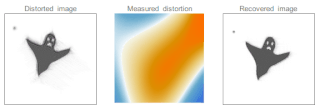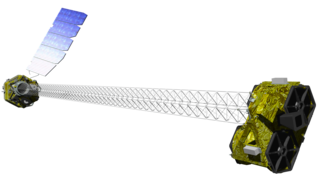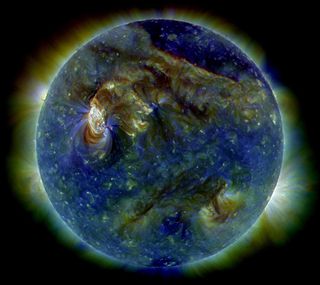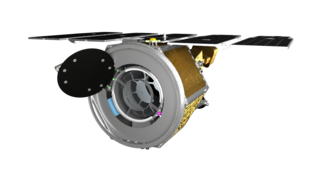
X-ray astronomy is an observational branch of astronomy which deals with the study of X-ray observation and detection from astronomical objects. X-radiation is absorbed by the Earth's atmosphere, so instruments to detect X-rays must be taken to high altitude by balloons, sounding rockets, and satellites. X-ray astronomy uses a type of space telescope that can see x-ray radiation which standard optical telescopes, such as the Mauna Kea Observatories, cannot.

Adaptive optics (AO) is a technique of precisely deforming a mirror in order to compensate for light distortion. It is used in astronomical telescopes and laser communication systems to remove the effects of atmospheric distortion, in microscopy, optical fabrication and in retinal imaging systems to reduce optical aberrations. Adaptive optics works by measuring the distortions in a wavefront and compensating for them with a device that corrects those errors such as a deformable mirror or a liquid crystal array.
The Extreme ultraviolet Imaging Telescope (EIT) is an instrument on the SOHO spacecraft used to obtain high-resolution images of the solar corona in the ultraviolet range. The EIT instrument is sensitive to light of four different wavelengths: 17.1, 19.5, 28.4, and 30.4 nm, corresponding to light produced by highly ionized iron (XI)/(X), (XII), (XV), and helium (II), respectively. EIT is built as a single telescope with a quadrant structure to the entrance mirrors: each quadrant reflects a different colour of EUV light, and the wavelength to be observed is selected by a shutter that blocks light from all but the desired quadrant of the main telescope.

Transition Region and Coronal Explorer was a NASA heliophysics and solar observatory designed to investigate the connections between fine-scale magnetic fields and the associated plasma structures on the Sun by providing high-resolution images and observation of the solar photosphere, the transition region, and the solar corona. A main focus of the TRACE instrument is the fine structure of coronal loops low in the solar atmosphere. TRACE is the third spacecraft in the Small Explorer program, launched on 2 April 1998, and obtained its last science image on 21 June 2010, at 23:56 UTC.

The Array of Low Energy X-ray Imaging Sensors X-ray telescope featured curved mirrors whose multilayer coatings reflected and focused low-energy X-rays or extreme ultraviolet (EUV) light the way optical telescopes focus visible light. The satellite and payloads were funded by the United States Department of Energy and built by Los Alamos National Laboratory (LANL) in collaboration with Sandia National Laboratories and the University of California-Space Sciences Lab. The satellite bus was built by AeroAstro, Inc. of Herndon, VA. The Launch was provided by the United States Air Force Space Test Program on a Pegasus Booster on April 25, 1993. The mission was entirely controlled from a small groundstation at LANL.

NuSTAR is a NASA space-based X-ray telescope that uses a conical approximation to a Wolter telescope to focus high energy X-rays from astrophysical sources, especially for nuclear spectroscopy, and operates in the range of 3 to 79 keV.

Extreme ultraviolet lithography is a technology used in the semiconductor industry for manufacturing integrated circuits (ICs). It is a type of photolithography that uses 13.5 nm extreme ultraviolet (EUV) light from a laser-pulsed tin (Sn) plasma to create intricate patterns on semiconductor substrates.
Arthur Bertram Cuthbert Walker Jr. was an African-American solar physicist and a pioneer of EUV/XUV optics. He developed normal incidence multilayer XUV telescopes to photograph the solar corona. Two of his sounding rocket payloads, the Stanford/MSFC Rocket Spectroheliograph Experiment and the Multi-Spectral Solar Telescope Array, recorded the first full-disk, high-resolution images of the Sun in XUV with conventional geometries of normal incidence optics. This technology is used in solar telescopes such as SOHO/EIT and TRACE, and in the fabrication of microchips via ultraviolet photolithography.

Extreme ultraviolet radiation or high-energy ultraviolet radiation is electromagnetic radiation in the part of the electromagnetic spectrum spanning wavelengths shorter than the hydrogen Lyman-alpha line from 121 nm down to the X-ray band of 10 nm. By the Planck–Einstein equation the EUV photons have energies from 10.26 eV up to 124.24 eV where we enter the X-ray energies. EUV is naturally generated by the solar corona and artificially by plasma, high harmonic generation sources and synchrotron light sources. Since UVC extends to 100 nm, there is some overlap in the terms.

An X-ray telescope (XRT) is a telescope that is designed to observe remote objects in the X-ray spectrum. X-rays are absorbed by the Earth's atmosphere, so instruments to detect X-rays must be taken to high altitude by balloons, sounding rockets, and satellites.
X-ray optics is the branch of optics dealing with X-rays, rather than visible light. It deals with focusing and other ways of manipulating the X-ray beams for research techniques such as X-ray diffraction, X-ray crystallography, X-ray fluorescence, small-angle X-ray scattering, X-ray microscopy, X-ray phase-contrast imaging, and X-ray astronomy.

Hinode, formerly Solar-B, is a Japan Aerospace Exploration Agency Solar mission with United States and United Kingdom collaboration. It is the follow-up to the Yohkoh (Solar-A) mission and it was launched on the final flight of the M-V rocket from Uchinoura Space Center, Japan on 22 September 2006 at 21:36 UTC. Initial orbit was perigee height 280 km, apogee height 686 km, inclination 98.3 degrees. Then the satellite maneuvered to the quasi-circular Sun-synchronous orbit over the day/night terminator, which allows near-continuous observation of the Sun. On 28 October 2006, the probe's instruments captured their first images.

The Extreme Ultraviolet Explorer was a NASA space telescope for ultraviolet astronomy. EUVE was a part of NASA's Explorer spacecraft series. Launched on 7 June 1992 with instruments for ultraviolet (UV) radiation between wavelengths of 7 and 76 nm, the EUVE was the first satellite mission especially for the short-wave ultraviolet range. The satellite compiled an all-sky survey of 801 astronomical targets before being decommissioned on 31 January 2001.
The NIXT, or Normal Incidence X-ray Telescope, was a sounding rocket payload flown in the 1990s by Professor Leon Golub of the Smithsonian Astrophysical Observatory, to prototype normal-incidence (conventional) optical designs in extreme ultraviolet (EUV) solar imaging. In the EUV, the surface of the Sun appears dark, and hot structures in the solar corona appear bright; this allows study of the structure and dynamics of the solar corona near the surface of the Sun, which is not possible using visible light.
Richard Brice Hoover is a physicist who has authored 33 volumes and 250 papers on astrobiology, extremophiles, diatoms, solar physics, X-ray/EUV optics and meteorites. He holds 11 U.S. patents and was 1992 NASA Inventor of the Year. He was employed at the United States' NASA Marshall Space Flight Center from 1966 to 2012, where he worked on astrophysics and astrobiology. He established the Astrobiology Group there in 1997 and until his retirement in late 2011 he headed their astrobiology research. He conducted research on microbial extremophiles in the Antarctic, microfossils, and chemical biomarkers in precambrian rocks and in carbonaceous chondrite meteorites. Hoover has published claims to have discovered fossilized microorganisms in a collection of select meteorites on multiple occasions.

Craig Edward DeForest is an American heliophysicist and the former Chair of the American Astronomical Society's Solar Physics Division. He is Director of the Department of Solar and Heliospheric Physics at the Boulder, Colorado offices of the Southwest Research Institute. His wide-ranging contributions to the field of experimental astrophysics of the Sun include: early work on the MSSTA, a sounding rocket that prototyped modern normal-incidence EUV optics such as are used on the Solar Dynamics Observatory; his discovery of sound waves in the solar corona in 1998; standardization of computer vision techniques that are used to measure and track magnetic fields on the solar surface; co-invention with colleague Charles Kankelborg of the fluxon semi-Lagrangian approach to numerical MHD modeling; and pioneering work on quantitative remote sensing of the solar wind via Thomson scattered light.

The Focusing Optics X-ray Solar Imager, or FOXSI, is a sounding rocket payload built by UC Berkeley and led by Säm Krucker to test high energy grazing-incidence focusing optics paired with solid-state pixelated detectors to observe the Sun. FOXSI is composed of seven identical Wolter-I telescope modules, as well as Silicon and Cadmium Telluride strip detectors originally developed for the HXT telescope on the Japanese Hitomi mission. The FOXSI payload flew two times, most recently in 2014 and previously in 2012, on the Black Brant IX sounding rocket. Like most sounding rockets, FOXSI flew for approximately 15 minutes per mission and observed the Sun for about 5 minutes while in space. During its first flight, FOXSI successfully imaged a solar microflare in the hard x-ray band for the first time.

Hakeem Muata Oluseyi is an American astrophysicist, cosmologist, inventor, educator, science communicator, author, actor, veteran, and humanitarian.

The Extreme-ultraviolet Stellar Characterization for Atmospheric Physics and Evolution (ESCAPE) mission aims to find environments beyond Earth's solar system that might host planets with thick atmospheres to support life.

Lobster-eye optics are a biomimetic design, based on the structure of the eyes of a lobster with an ultra wide field of view, used in X-ray optics. This configuration allows X-ray light to enter from multiple angles, capturing more X-rays from a larger area than other X-ray telescopes. The idea was originally proposed for use in X-ray astronomy by Roger Angel in 1979, with a similar idea presented earlier by W. K. H. Schmidt in 1975. It was first used by NASA on a sub-orbital sounding rocket experiment in 2012. The Lobster Eye Imager for Astronomy, a Chinese technology demonstrator satellite, was launched in 2022. The Chinese Einstein Probe, launched in 2024, is the first major space telescope to use lobster-eye optics. Several other such space telescopes are currently under development or consideration.















